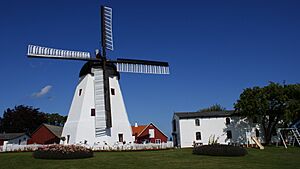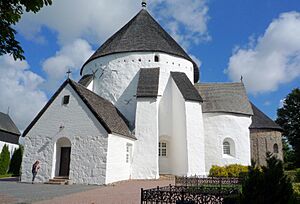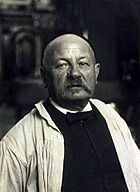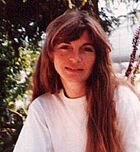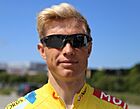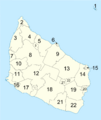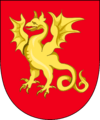Bornholm facts for kids
 |
|
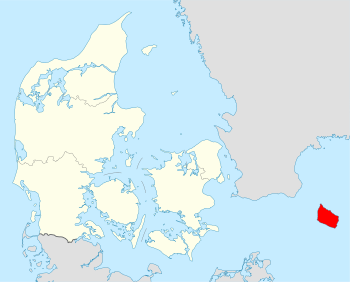 |
|
| Geography | |
|---|---|
| Location | Baltic Sea |
| Coordinates | 55°8′N 14°55′E / 55.133°N 14.917°E |
| Area | 588.36 km2 (227.17 sq mi) |
| Highest elevation | 162 m (531 ft) |
| Highest point | Rytterknægten |
| Administration | |
| Region | Capital Region |
| Municipality | Bornholm |
| Largest settlement | Rønne (pop. 13,772 (2020)) |
| Demographics | |
| Population | 39,332 (January 2024) |
| Pop. density | 66.85 /km2 (173.14 /sq mi) |
Bornholm is a Danish island located in the Baltic Sea. It sits east of the rest of Denmark, south of Sweden, northeast of Germany, and north of Poland.
Because of its important location, Bornholm has been a place of many battles over hundreds of years. Denmark usually ruled it, but Sweden and the city of Lübeck also took control at times. The ruins of Hammershus fortress, found on the island's northwest tip, are the biggest medieval fortress in northern Europe. This shows how important Bornholm's location was.
Bornholm is often called "sunshine island" (solskinsøen) because of its sunny weather. It's also known as "rock island" (klippeøen) due to its geology, which is mostly granite. This rock stores heat from the summer, keeping the island warm until October. A special type of common fig, called Bornholm's Diamond, even grows here because of the climate.
The northern part of the island has dramatic rock formations, which is different from most of Denmark's gentle hills. These rocks slope down to forests, farms, and sandy beaches in the south. Bornholm is also home to many of Denmark's unique round churches. The island covers about 588 square kilometers (227 square miles) and had a population of 39,332 people in January 2024.
Contents
- Exploring Bornholm's Past
- How Bornholm is Governed
- Getting Around Bornholm
- Towns and Villages on Bornholm
- Bornholm's Population Changes
- Bornholm's Language and Religion
- Places to See on Bornholm
- Education on Bornholm
- Bornholm's Economy
- Electricity on Bornholm
- Military Presence
- Bornholm's Climate
- Sports and Activities
- Famous People from Bornholm
- Images for kids
- See also
Exploring Bornholm's Past
How Bornholm Got Its Name
In old languages, Bornholm was called Burgundaholmr or Borghand. These names likely came from words meaning 'height' or 'mountain' because the island rises high out of the sea. Some historians even think the Burgundians, a Germanic group who settled in France, might have been named after Bornholm.
Important Events in Modern History
Bornholm was once given to the city of Lübeck for 50 years, starting in 1525. The island's first local army, the Bornholms Milits, was created in 1624. Swedish forces took over the island in 1645, but they gave it back to Denmark soon after.
In 1658, Denmark had to give Bornholm to Sweden after a war. But the people of Bornholm started a revolt that same year. They fought back and eventually gave the island back to the Danish kings in 1660.
At the beginning of the 20th century, many famous artists came to Bornholm. They formed a group called the Bornholm school of painters. These artists included Oluf Høst, Karl Isaksson, Edvard Weie, Olaf Rude, Niels Lergaard, and Kræsten Iversen.
Bornholm During World War II
During World War II, on August 22, 1942, a German V-1 flying bomb crashed on Bornholm during a test. This was one of the first clues British spies had about Germany's plans to build flying bombs and rockets.
In May 1945, just as the war was ending, Soviet planes bombed the two main towns on Bornholm. On May 9, Soviet troops landed on the island. After a short fight, the German soldiers on Bornholm surrendered. The Soviet forces stayed on the island until April 5, 1946.
Bornholm in the Cold War
After leaving Bornholm, the Soviet Union warned that if any foreign troops were stationed there, it would be seen as an act of war. Denmark, a founding member of NATO, kept its own troops on the island. The Soviets accepted Danish troops but strongly opposed any other NATO troops, especially from the US.
In 1953, a Polish pilot named Franciszek Jarecki flew his MiG-15 fighter jet to Bornholm. He was given a safe place to stay and was rewarded for giving Western spies information about the Soviet Union's newest jet fighter.
In 2017, Denmark's intelligence service decided to build a tall listening tower near Østermarie. This tower, almost 90 meters high, helps them listen to radio communications across the Baltic Sea and in parts of Russia.
How Bornholm is Governed
Bornholm Regional Municipality is the local government that manages the entire island. It was created on January 1, 2003, by combining the five smaller towns and the former Bornholm County. This means Bornholm has its own special local government.
The main office for the island's government is in Rønne, the largest town. In 2001, the people of Bornholm voted to combine all their local governments into one. About 74% of voters said yes to this idea.
The local council for Bornholm today has 23 members. These members are elected every four years. The first mayor of the new combined municipality was Thomas Thors, who was a doctor and a member of the Social Democrats party.
Getting Around Bornholm
You can reach Bornholm by ferry from Świnoujście in Poland, Sassnitz in Germany, and Køge in Denmark. There are also fast catamaran services to Ystad in Sweden. During the summer, you can take a ferry to Simrishamn in Sweden.
Bornholm also has its own airport, Bornholm Airport, with flights to Copenhagen and other places. Because of its location, Bornholm has its own public transport company, BAT. It also handles other services that larger regions usually manage in Denmark.
Towns and Villages on Bornholm
Most of the larger towns on Bornholm are located along the coast and have harbors. The only main town not on the coast is Aakirkeby, which is in the center of the island.
The biggest town is Rønne, located in the southwest. Other important towns around the island include Hasle, Sandvig, Allinge, Gudhjem, Svaneke, and Nexø.
In 2018, the populations of the main towns were:
- Rønne: 12,887
- Nexø: 3,644
- Aakirkeby: 2,083
- Hasle: 1,622
- Allinge-Sandvig: 1,489
- Svaneke: 1,078
- Tejn: 890
- Gudhjem: 723
- Snogebæk: 715
- Nyker: 701
- Klemensker: 639
- Sorthat-Muleby: 519
- Østermarie: 486
- Aarsdale: 387
Bornholm's Population Changes
On September 22, 2014, the number of people living on Bornholm dropped below 40,000 for the first time in over 100 years. The local government recorded 39,922 residents on that day.
| Historical population | ||
|---|---|---|
| Year | Pop. | ±% |
| 1850 | 27,927 | — |
| 1901 | 40,677 | +45.7% |
| 1916 | 43,445 | +6.8% |
| 1925 | 45,550 | +4.8% |
| 1935 | 45,819 | +0.6% |
| 1945 | 47,185 | +3.0% |
| 1955 | 48,475 | +2.7% |
| 1965 | 48,620 | +0.3% |
| 1976 | 47,242 | −2.8% |
| 1981 | 47,370 | +0.3% |
| 1986 | 46,919 | −1.0% |
| 1990 | 45,784 | −2.4% |
| 1995 | 44,823 | −2.1% |
| 2000 | 44,238 | −1.3% |
| 2005 | 43,347 | −2.0% |
| 2010 | 41,802 | −3.6% |
| 2015 | 39,842 | −4.7% |
| 2020 | 39,499 | −0.9% |
| Source: statistikbanken.dk Statistical Yearbook 2009: Area and population. Regions and inhabited islands | ||
Bornholm's Language and Religion
Many people on Bornholm speak a special dialect called Bornholmsk. It is officially considered a dialect of Danish.
Most people on the island are members of the Lutheran Church of Denmark (Folkekirken). Over the years, other Christian groups have also started churches on the island, especially during the 1800s.
Places to See on Bornholm
Bornholm's unique geology is easy to spot. You can see active granite quarries like Stubbeløkken and Klippeløkken near Rønne. The island's varied landscapes and sea views attract many visitors.
Some popular spots include the Hammeren promontory in the northwest and the Dueodde beaches in the southeast. Don't miss the rocky sea cliffs at Jons Kapel and Helligdomsklipperne. You can also explore beautiful valleys like Ekkodalen and Døndalen.
Bornholm has many windmills, including the old post mill of Egeby and the well-kept Dutch mill at Aarsdale. The Dueodde Lighthouse is Denmark's tallest, and the Hammeren Lighthouse stands high above the sea.
The island also has examples of old architecture from the 1800s and early 1900s. About 300 wooden houses in Rønne and Nexø were given by Sweden after World War II to help the island rebuild.
Bornholm is home to 15 medieval churches, including four special round churches with unique designs. The ancient site of Rispebjerg has remains of old sun temples and earthworks. You can also find 14 European bison near Åkirkeby, which attract many visitors each year.
Education on Bornholm
All secondary schools and adult education classes in Rønne are moving to new buildings at Campus Bornholm in 2018. Campus Bornholm is a group of schools that joined together in 2010. This new campus will bring many learning institutions to one location.
Bornholm's Economy
Bornholm's main industries include dairy farming and making arts and crafts. Artists on the island create beautiful glass items and pottery using local clay.
Jensen-Group, a company that makes industrial washing machines, started on Bornholm and has a factory in Rønne. Tourism is also very important, especially during the summer months.
Electricity on Bornholm
Bornholm is part of a big project called EcoGrid. This project tests new ways to manage energy networks that use a lot of renewable energy, like wind turbines and solar panels. The European Union helps fund 50% of this project.
Military Presence
Almegårds Kaserne on Bornholm is home to the III Reconnaissance Battalion (III/GHR) from the Guard Hussar Regiment, which is part of the Danish military.
Bornholm's Climate
Bornholm has an oceanic climate, similar to southern Sweden and mainland Denmark. Its location near the sea keeps summer temperatures from getting too hot and winter temperatures from getting too cold. The island is usually sunny in summer, and it doesn't get a lot of rain.
The winter of 2010-2011 was very extreme, with snow reaching at least 146 centimeters (58 inches) deep. Some snowdrifts were even six meters (20 feet) high! The military had to help clear the roads.
| Climate data for Bornholm (1971–2000) | |||||||||||||
|---|---|---|---|---|---|---|---|---|---|---|---|---|---|
| Month | Jan | Feb | Mar | Apr | May | Jun | Jul | Aug | Sep | Oct | Nov | Dec | Year |
| Record high °C (°F) | 8.9 (48.0) |
9.7 (49.5) |
15.1 (59.2) |
26.6 (79.9) |
27.2 (81.0) |
31.7 (89.1) |
31.9 (89.4) |
32.0 (89.6) |
27.9 (82.2) |
20.2 (68.4) |
15.7 (60.3) |
11.0 (51.8) |
32.0 (89.6) |
| Mean daily maximum °C (°F) | 2.7 (36.9) |
2.4 (36.3) |
4.5 (40.1) |
8.9 (48.0) |
14.5 (58.1) |
17.9 (64.2) |
20.1 (68.2) |
20.5 (68.9) |
16.4 (61.5) |
11.9 (53.4) |
7.3 (45.1) |
4.4 (39.9) |
10.9 (51.6) |
| Daily mean °C (°F) | 0.9 (33.6) |
0.4 (32.7) |
2.1 (35.8) |
5.5 (41.9) |
10.5 (50.9) |
14.3 (57.7) |
16.8 (62.2) |
17.0 (62.6) |
13.4 (56.1) |
9.5 (49.1) |
5.4 (41.7) |
2.6 (36.7) |
8.2 (46.8) |
| Mean daily minimum °C (°F) | −1.1 (30.0) |
−1.7 (28.9) |
−0.4 (31.3) |
2.1 (35.8) |
6.6 (43.9) |
10.7 (51.3) |
13.3 (55.9) |
13.4 (56.1) |
10.5 (50.9) |
6.9 (44.4) |
3.2 (37.8) |
0.5 (32.9) |
5.3 (41.5) |
| Record low °C (°F) | −15.7 (3.7) |
−17.7 (0.1) |
−16.1 (3.0) |
−7 (19) |
−3 (27) |
−0.2 (31.6) |
4.0 (39.2) |
5.4 (41.7) |
−0.2 (31.6) |
−5.7 (21.7) |
−10.1 (13.8) |
−14.1 (6.6) |
−17.7 (0.1) |
| Average precipitation mm (inches) | 40.2 (1.58) |
22.8 (0.90) |
30.6 (1.20) |
30.2 (1.19) |
31.9 (1.26) |
44.2 (1.74) |
47.1 (1.85) |
41.4 (1.63) |
55.5 (2.19) |
50.2 (1.98) |
52.1 (2.05) |
42.4 (1.67) |
488.7 (19.24) |
| Average precipitation days (≥ 0.1 mm) | 16.5 | 12.9 | 13.7 | 11.2 | 10.0 | 11.0 | 10.6 | 10.8 | 13.2 | 14.5 | 16.7 | 16.1 | 157.3 |
| Average snowy days | 5.6 | 5.3 | 4.0 | 0.9 | 0.1 | 0.0 | 0.0 | 0.0 | 0.0 | 0.0 | 1.8 | 3.4 | 21.2 |
| Mean monthly sunshine hours | 35 | 53 | 112 | 190 | 284 | 266 | 276 | 252 | 155 | 102 | 46 | 31 | 1,809 |
| Source: Danish Meteorological Institute | |||||||||||||
Sports and Activities
Bornholm's island geography and mild climate make it a great place for sailing and other water sports. It has also become a well-known spot for 'match racing', a type of sailing where two identical boats race against each other. The Danish Open sailing event was held in Rønne in 2010.
The island has two small stadiums. Nexø Stadion in Nexø is where the NB Bornholm football club plays. The slightly larger Rønne Stadion Nord in Rønne is used by the Bornholm national football team and other local sports clubs.
Famous People from Bornholm
Artists and Creative People
- Kristian Zahrtmann (1843 in Rønne – 1917) – A painter known for his realistic art.
- Michael Ancher (1849 in Rutsker – 1927) – A realist artist who painted fishermen.
- Mathias Bidstrup (1852 in Rønne – 1929) – An architect who designed many buildings on Bornholm, including churches and train stations.
- Oluf Høst (1884 in Svaneke – 1966) – An Expressionist painter and the only native member of the Bornholm school of painters.
- Gertrud Vasegaard (1913 in Rønne – 2007) – A ceramist famous for her stoneware.
- Pia Ranslet (born 1956 in Allinge) – A painter and sculptor.
- Klaus Bondam (born 1963 in Aakirkeby) – An actor and former politician.
- Aura Dione (born 1985) – A pop singer and songwriter who lived on Bornholm from age seven.
Scientists and Thinkers
- Johan Nicolai Madvig (1804 in Svaneke – 1886) – A Danish scholar of languages and history.
- Peter Ludvig Panum (1820 in Rønne – 1885) – A physiologist and pathologist.
- Dr. Lilli Nielsen (1926 in Rønne – 2013) – A psychologist who taught blind children.
Business Leaders
- M.P. Möller (1854 in Østermarie – 1937) – A builder of pipe organs who moved to the United States.
- Nicolai Nørregaard (born 1979 in Svaneke) – A famous chef and restaurant owner.
Public Figures
- Martin Andersen Nexø (1869–1954) – A socialist writer who moved to the island when he was 8 years old.
- Vilhelm Grønbech (1873 in Allinge – 1948) – A cultural historian and professor.
- Lea Wermelin (born 1985 in Rønne) – A Danish politician who served as Minister for the Environment.
Athletes
- Allan Kuhn (born 1968 in Rønne) – A Danish football coach and former player.
- Magnus Cort (born 1993) – A professional road bicycle racer.
- Mathias Christiansen (born 1994) – A badminton player.
Images for kids
See also
 In Spanish: Bornholm para niños
In Spanish: Bornholm para niños


